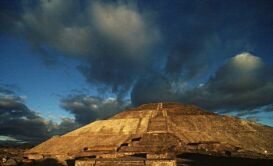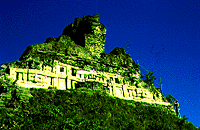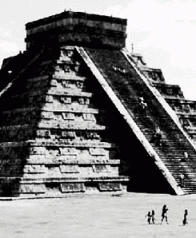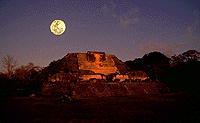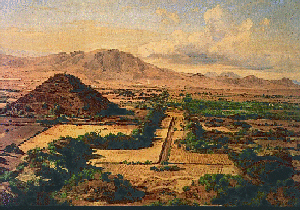America: Fear of the Dark I
'The first world was destroyed, as a punishment for human misdemeanors, by an all-consuming fire that came from above and below. The second world ended when the terrestrial globe toppled from its axis and everything was covered with ice. The third world ended in a universal flood. The present world is the fourth. Its fate will depend on whether its inhabitants behave in accordance with the Creator's plans.' [Hopi Myth]
The above quotation comes from the tradition of the North American Hopi tribe - through what remains of the oral tradition brought down from their ancestors. There are mysteries relating to this investigation scattered throughout the North American continent. But for the source of the New World's ancient traditions scholars have ever turned their gaze southwards, to the faded traditions of the Aztecs, the elder Maya, Olmecs, and, farther south in the Andes - to the civilization of the early Incas.
No thanks to the Iberian-Catholic occupation of South and Central America however, the vast majority of the 'literary monuments', marvels and artefacts of the New World were destroyed in fits of religious hysteria, stolen, or - like the massive gold and silver calendars of Mexico were - melted down and sent back to the Old World for coin.
What could not be stolen, excavated, sold to museums, or destroyed was left as silent testimony to the brilliance of the long-faded civilization. And that which was not buried or destroyed by cataclysms or the hand of civilizations, was overwhelmed and lost to the jungle. But time, and the hand of civilization have once again uncovered them, revealing monuments on the same scale of magnificence as those found at the more famous Giza complex, in Egypt.
On the spring and autumn equinoxes of every year a mysterious phenomenon takes place upon the 365 steps of the pyramid at Kukulcan, in Chiten Itza, Mexico. Patterns of light and shadow combine to create the illusion of a huge serpent undulating up the staircase towards the top of the pyramid. It lasts exactly three hours and twenty-two minutes.
Tenochtitlan, now the old part of Mexico City, when discovered by Cortes in 1519, was an Aztec city of vast pyramids and temples, palaces and canals and was built in the middle of a massive lake. It was as sophisticated as Madrid or Venice. The Aztecs told Cortes that the city was modeled on the original capital of their lost homeland, standing in the middle of the lake and surrounded by concentric canals.
Teotihuacan, a city the Aztecs tell was built by their earliest ancestors, lies fifty kilometers north-east of Mexico City and was called the 'city of gods', or 'city where gods are born'.
'The vast area that the city covers means that it must, in its day, have been the largest metropolis in all the Americas. Indeed, even in the Old World there would have been few cities to match it. Teotihuacan, like Mexico City today, was built on a grid system of streets. Its most imposing feature, however, besides the great pyramids, is a grand avenue that runs for some ten kilometers before culminating in front of the Pyramid of the Moon.'[3]
The first excavations in 1883, at the Temple of Quetzalcoatl, unearthed pottery and masks portraying an incredible variety of different faces - including those of Caucasians, Greeks, Japanese, Negroes and Mongols. At some point in history, it seems, the land of the Aztecs and the earlier Mayas was a cosmopolitan centre on par with such great cities as Constantinople.
'The great Pyramids of the Sun and Moon at Teotihuacan have, rightly, been compared with the pyramids of Giza. Colossal in size, it is almost beyond belief that their builders were able to erect such huge monuments with the primitive tools then available.'[2]
Remember, academics hold that the wheel was never discovered in the Americas, and beasts of burden such as the horse went extinct in the New World some time around the end of the last Ice Age. (The American archeologist Matthew Stirling discovered children's toys in the form of little wheeled dogs in Tres Zapotes, a site associated with the early Olmecs, but like similar evidence that doesn't fit into the 'archeological picture', the discovery has largely gone ignored.)
'The city flourished throughout the classic period, at the time that the Maya built Palenque, and was abandoned, for reasons unknown, in about AD 750. In his dig Bartres found evidence that the city had been destroyed by a great fire. At first sight this suggested that it had met its end at the hands of invaders, for who else would have put it to the torch? Yet there was another curious anomaly: many of the buildings also showed evidence that they had been deliberately filled with rubble and buried so that even the roof timbers were still intact. It was as if they had been preserved in aspic.'[3]
Burned and then buried by man, or perhaps by nature. In 1884 an ex-soldier and self-styled archeologist Leopoldo Batres persuaded his brother-in-law, the infamous dictator Porfiro Diaz, to allow him to excavate at Teotihuacan.
'Bartres was less interested in archaeology than in finding treasure, or pottery and artefacts that could be sold to European museums. He was puzzled by the sheer quantity of earth and rubble that covered the city - as if, he speculated, the inhabitants had deliberately buried it to protect it from sacrilegious invaders. His excavations revealed that the city had probably been abandoned after some catastrophe that had set it on fire; many buildings were full of charred skeletons.'[4]
On the flat top of the Pyramid of the Sun, under the rubble in the remains of a temple were found human figures of jade, jasper, alabaster and human bone. He also found a kind of flute that produced a seven note scale unlike the European scale. An entrance into the pyramid was discovered accidentally in 1971, which led to a spacious cave close to it's geometrical centre. The cave has four adjoining chambers, much like the leaves to a four-leaved clover, each about sixty feet in circumference. There was also a complex drainage system of interlocking segments of carved rock pipes.
An American engineer, Alfred E. Schlemmer, whose field was technological forecasting, with specific reference to the prediction of earthquakes, studied the city from his technical perspective. His proposal regarding a part of the function of the 'Street of the Dead' at Teotihuacan is of interest ion this matter. I will quote Graham Hancock, who includes his own observations:
'Schlemmer's argument was that the Street of the Dead might never have been a street at all. Instead it might originally have been laid out as a row of linked reflecting pools, filled with water which had descended through a series of locks from the Pyramid of the Moon, at the northern extreme, to the Citadel in the South ... it seemed to me that this theory had several points in its favour. For a start the 'Street' was blocked at regular intervals by high partition walls, at the foot of which the remains of well-made sluices could clearly be seen. Moreover, the lie of the land would have facilitated a north-south hydraulic flow since the base of the Moon Pyramid stood on ground that was approximately 100 feet higher than the area in front of the Citadel. The partitions could easily have been filled with water and might indeed have served as reflecting pools, creating a spectacle far more dramatic than those offered by the Taj Mahal or the fabled Shamilar Gardens.
The Teotihuacan Mapping Project had demonstrated conclusively that the ancient city had possessed 'many carefully-laid out canals and systems of branching waterways, artifically dredged into straightened portions of a river, which formed a network within Teotihuacan and ran all the way to Lake Texcoco, now ten miles distant but perhaps closer in antiquity'.
There was much argument as to what this vast hydraulic system had been designed to do. Schlemmer's contention was that the particular waterway he had identified had been built to serve a pragmatic purpse as 'a long-range seismic monitor' - part of 'an ancient science, no longer understood.' He pointed out that remote earthquakes 'can cause standing waves to form on a liquid surface right across the planet' and suggested that the carefully graded and spaced reflecting pools of the Street of the Dead might have been designed 'to enable the Teotihuacanos to read from the standing waves formed there the location and strength of earthquakes around the globe, thus allowing them to predict such an occurence in their own area'.[1]
Schlemmer's argument is supported by the fact that the Pyramid of the Moon has an even more complex system of sluices inside it than the Pyramid of the Sun. It is also reinforced by what remains of the 'literary monuments' of this ancient culture. The Mayan priests were fascinated - to the point of preoccupation - with the seasons, planets, solar ages, precession of equinoxes, and the cycles of destruction they believed accompanied them. In fact, of all the 'star gazing' and calendar-making civilizations of the ancient world, those of the Maya and their predecessors appeared pre-eminient. Schlemmer writes:
'In the Maya scheme the road over which time had marched stretched into a past so distant that the mind of man cannot comprehend its remoteness. Yet the Maya undauntedly retrod that road seeking its starting point. A fresh view, leading further backward, unfolded at every stage; the mellowed centuries blended into millennia, and they into tens of thousands of years, as those tireless inquirers explored deeper and still deeper into the eternity of the past. On a stela at Quiriga in Guetemala a date over 90 million years ago is computed; on another a date 300 million years before that was given. These are actual computations, stating correctly day and month positions, and are comparable to calculations in our calendar giving the month positions on which Easter would have fallen at equivalent distances in the past. The brain reels at such astronomical figures...'
Why they should be possessed to study the stars, the cycles of the planet and the mechanics of their calendar with such urgency remains a matter of bafflement and endless speculation.
The 'great pyramid' of the Mayas at Cholula, by Mexico City, covers an area of 45 acres and is the largest building on earth. It is three times as massive as the Great Pyramid of Giza. The conquistadors were not gentle with this, the most ancient and massive of all of Americas pyramids.
'In Cholula, a great centre of pilgrimage with a population of around 100,000 at the time of the conquest, the decapitation of ancient traditons and ways of life required that something particularly humiliating be done to the man-made mountain of Quetzalcoatl. The solution was to smash and desecrate the temple which had once stood on the summit of the ziggurat and replace it with a church.
Because the Cholulans thought Cortez and his men to be Quetzalcoatl and his followers, returning from across the 'Eastern Sea' as prophesied, the conquistadores were give permission to enter the great courtyard of the temple. There troupes of gaily bedecked dancing girls greeted them with platters of bread and delicate cooked meats.
One of the Spanish chroniclers, an eyewitness to the events that followed, reported that adoring townsfolk of all ranks, 'unarmed, with eagre and happy faces, crowded in to hear what the white men had to say'. Realizing from this incredible reception that their intentions were not suspected, the Spaniards closed and guarded all the entrances, drew their weapons of steel and murdered their hosts. 'Those of Cholula were caught completely unawares. With neither arrows nor shields did they meet the Spaniards. Just so they were slain without warning. They were killed by pure treachery.' Six thousand died in this massacre.'[1]
The rage lives on, in silence. But the mystery surrounding the pyramid gets stranger yet. Diego de Duran, a Franciscan collector of indigenous traditions, visited Cholula in 1585 and interviewed a venerated elder of town, said to be more than a hundred years old. The elder told him the following story about the building of the ziggurat:
'In the beginning, before the light of the sun had been created, this place, Cholula, was in obscurity and darkness; all was a plain, without hill or elevation, encircled in every part by water, without tree or created thing. Immediately after the light and the sun arose in the east there appeared giant men of deformed stature who possessed the land. Enamoured by the light and beauty of the sun, they determined to build a tower so high that it's summit should reach the sky. Having collected materials for the prupose they found a very adhesive clay and bitumen with which they speedily commenced to build the tower ... And having reared it to the greatest possible altitude, so that it reached the sky, the Lord of the Heavens, enraged, said to the inhabitants of the sky, 'Have you observed how they of the earth have built a high and haughty tower to mount hither, being enamoured of the light of the sun and it's beauty? Come and confound them, because it is not right that they of the earth, living in the flesh, should mingle with us.' Immediately the inhabitants of the sky sallied forth like flashes of lightning; they destroyed the edifice and divided and scattered its builders to all parts of the earth.'[2]
A familiar legend, reminiscent of the biblical account of the Tower of Babel, which is itself a reworking of a much older Mesopotamian legend. It would appear that another reworking of the same tradition lived on in it's own version in America. Though academics do not yet recognize a connection beween the pyramids of the Americas and those of Egypt, it is clear that in the mythological tradition, they have a connection strong enough to pass on almost exactly the same story. Legends of giants are also, of course, to be found in the biblical Book of Gensis.
'Isn't it odd that the symbolic language keeps cropping up in ancient traditions around the world? How can this be explained? Are we talking about some vast, subconscious wave of telepathy, or could elements of these remarkable universal myths have been engineered, long ages ago, by clever and purposeful people?'[1]
It almost appears as if, though there was little or no direct connection in the time that the pyramids in both the New and Old Worlds were actually built, the peculiar tradition that motivated cultures on either side of the Atlantic to build them does spring from a common source. A common source that perhaps also painstakingly executed maps of an ice-free Antarctica before crustal displacements ultimately buried it under a mile-thick mantle of ice. A source that was once reckoned to be a maritime civilization of expert navigators, architects, mathematicians, and astronomers.
CONTINUE
[Apocalypse Aerie] [The Einstein Connection] [Ancient Maps] [Earth Crust Displacement] [Myths of Catastrophism] [History & Science in Myth] [Egypt; The Call of the Sphinx] [India; A Cradle for Civilization] [America; Fear of the Dark] [World Ocean; Path to Atlantis] [Precession; Warning of the Ancients] [Epilogue & Links]
[View Guestbook] [View Old Guestbook] [Sign Guestbook] [ ]
[Home] [Other Work]
Copyright © Marc Bergvelt. 1998-2002. All Rights Reserved.
CLICK BACK ON BROWSER TO RETURN TO FOOTNOTE
[1] Graham Hancock, Fingerprints of the Gods, Mandarin, 1995.
[2] Diego de Duran, 'Historia antiqua de la Nueva Espana', from Ignatius Donelly, Atlantis, The Antedeluvian World.
[3] Adrian Gilbert & Maurice Cotterell, The Mayan Prohecies, Element Books, 1996.
[4] Colin Wilson, From Atlantis to the Spinx, Virgin Books, 1997.

